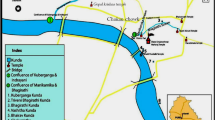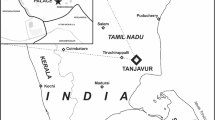Abstract
The hill fort of Raigad is a massive historical structure constructed with basaltic stone blocks and cemented together with lime mortar. The lime mortar samples from the fort were examined using a petrological microscope, grain size distribution, X-ray fluorescence (XRF), Fourier-transform infrared spectroscopy (FTIR), X-ray diffraction (XRD) and scanning electron microscope coupled with energy dispersive x-ray analysis (SEM–EDX). The mineralogical and compositional characteristic of the mortar was analyzed to provide a compatible repair mix for large scale restoration. Aggregates derived from weathering of basaltic rocks of Sahyadri hills were sourced from the vicinity of the fort. Non-hydraulic aerial lime of moderate porosity was specifically used in India's highly rain-fed Western Ghats for rapid evaporation of water and to prevent the build-up of salts. Thin section analysis and FTIR results indicate the use of organic proteinaceous material during the preparation of lime. FTIR analysis also showed the disorder in the man-made calcite crystals while XRD and SEM–EDX analysis elucidated the mixing of quartz and plagioclase feldspar derived from basaltic aggregates in the calcite matrix. The present study gives a holistic approach to prepare a compatible mortar for restoration.







Similar content being viewed by others
References
Berlucchi, N. and Corradini, R. Ginanni.(1995). Experimentation of a chemical-physical methodology for the reconstruction of historic mortars. In: Methods of Evaluating Products for the Conservation of Porous Building Materials in Monuments: Preprints of the International Colloquium, Rome, 19–21 June 1995. Rome, Italy: ICCROM
Blacker, V. (1821). Memoir of the Operations of the British Army in India during the Mahratta War of 1817, 1818, & 1819 (Vol. 1). London: Black.
Boynton, R. S. (1966). Chemistry and Technology of Time and Limestone. John Wiley & Sons Inc.
Chiari, G., Torraca, G., & Santarelli, M. L. (1996). Recommendations for systematic instrumental analysis of ancient mortars: The Italian experience. In: Standards for Preservation and Rehabilitation, Vol. 1258. West Conshohocken, PA: ASTM Spec. Tech. Publ.
Chu, V., Regev, L., Weiner, S., & Boaretto, E. (2008). Differentiating between anthropogenic calcite in plaster, ash and natural calcite using infrared spectroscopy: implications in archaeology. Journal of Archaeological Science, 35(4), 905–911.
Elsen, J. (2006). Microscopy of historic mortars—a review. Cement and Concrete Research, 36(8), 1416–1424.
Gourdin, W. H., & Kingery, W. D. (1975). The beginnings of pyrotechnology: Neolithic and Egyptian lime plaster. Journal of Field Archaeology, 2(1–2), 133–150.
Middendorf, B., Baronio, G., Callebaut, K., and Hughes, J. J. (2000). Chemical-mineralogical and physical-mechanical investigations of old mortars. In: Proceedings of the International RILEM-workshop on Historic Mortars: Characteristics and Tests. Paisley, Scotland.
Moropoulou, A., Bakolas, A., & Bisbikou, K.(2000). Investigation of the technology of historic mortars. Journal of Cultural Heritage, 1(1), 45–58.
Nelson, A. E. (1909). Central Provinces District Gazetteers: Drug District, Nagpur (Vol. A). Calcutta: Baptist Mission Press.
Panda, S. S., Mohapatra, P. K., Chaturvedi, R. K., & Kar, S. K. (2013). Chemical analysis of ancient mortar from excavation sites of Kondapur, Andhra Pradesh, India to understand the technology and ingredients. Current Science, 105(6), 837–842.
Papayianni, I. (1998). Criteria and Methodology for Manufacturing Compatible Repair Mortars and Bricks in PACT 56. Athens: Technical Chamber of Greece.
Ravi, R., Rajesh, M., & Thirumalini, S. (2018). Mechanical and physical properties of natural additive dispersed lime. Journal of Building Engineering, 15, 70–77.
Sawant-Kulkarni, N., & Shinde, V. (2015). Study of the military architectures and remains of the Shivneri fort, Maharashtra, India. Bulletin of Deccan College and Reserach Institute, 75, 125–134.
Selvaraj, T., & Ramadoss, R. (2018). Analysis and characterisation of third century ancient mortars at Subramanyaswamy temple rediscovered after the 2004 tsunami near Mamallapuram shore. India. International Journal of Conservation Science, 9(1), 25–38.
Singh, M. (1991). Analysis of Golkonda fort plaster. In 1st International Colloquiums on Role of Chemistry in Archaeology (pp. 81–86). Hyderabad, Andhra Pradesh, India: BACRI.
Singh, M. R., & Kumar, S. V. (2019) Architectural features and characterization of 16th century Indian monument Farah Bagh, Ahmed Nagar, India. International Journal of Architectural Heritage, 1–14.
Singh, S. K., & Singh, M. (2020). The mineralogical and physical behavior of brick aggregates in twelfth century brick-lime stepwell plasters of Gandhak-ki-baoli, New Delhi. Journal of Architectural Conservation, 26(2), 184–200.
Singh, M. R. (2017). Dolomitic plasters in Indian monuments and its characterization. Journal of Historical Archaeology & Anthropological, 1(6), 237–241.
Singh, M., & Kumar, S. V. (2018). Mineralogical, chemical, and thermal characterizations of historic lime plasters of thirteenth–sixteenth-century Daulatabad fort, India. Studies in Conservation, 63, 482–496. https://doi.org/10.1080/00393630.2018.1457765
Singh, M., Kumar, S. V., & Waghmare, S. A. (2015). Characterization of 6–11th century AD decorative lime plasters of rock cut caves of Ellora. Construction and Building Materials, 98, 156–170. https://doi.org/10.1016/j.conbuildmat.2015.08.039
Singh, M., Kumar, S. V., Waghmare, S. A., & Sabale, P. D. (2016). Aragonite vaterite-calcite: Polymorphs of CaCO3 in 7th century CE lime plasters of Alampur group of temples, India. Construction and Building Materials, 112, 386–387. https://doi.org/10.1016/j.conbuildmat.2016.02.191
Singh, M., Waghmare, S., & Kumar, S. V. (2014). Characterization of lime plasters used in 16th century Mughal monument. Journal of Archaeological Science, 42, 430–434.
Válek, J., Hughes, J.J., & Bartos, P. (2000). Compatibility of historic and modern lime mortars. In 12th International Brick/Block Masonry Conference Proceedings, 3, 2002.
Zheng, Y., Zhang, H., Zhang, B., & Yue, L. (2016). A new method in detecting the sticky rice component in traditional Chinese tabia. Archaeometry, 58, 218–229.
Acknowledgements
The authors are thankful to Prof. P.D. Sabale of Deccan College, Pune, Dr. L.P. Singh of CBRI, Roorkee, Shri Ghanshyam Lal of NRLC, Lucknow and Shri Deepak Gupta of Archaeological Survey of India, Aurangabad for their help in the analysis of samples. We are thankful to the staff of ASI, Raigad, and NRLC, Lucknow for their help and co-operation.
Author information
Authors and Affiliations
Corresponding author
Rights and permissions
About this article
Cite this article
Singh, M.R., Yadav, R. Microstructural analysis and characterization of lime mortar of seventeenth century Raigad hill fort from western India. Indian J Hist. Sci. 56, 217–227 (2021). https://doi.org/10.1007/s43539-021-00023-z
Received:
Accepted:
Published:
Issue Date:
DOI: https://doi.org/10.1007/s43539-021-00023-z




